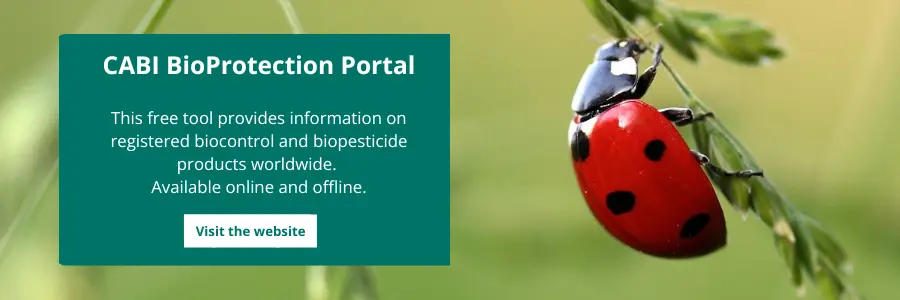Garlic formulations to control aphids in cabbage: Aphis gossypii;Brevicoryne brassicae;Myzus persicae
Publication: PlantwisePlus Knowledge Bank
Factsheets for Farmers
Recognize the problem
Cabbage suffers from aphid attacks. Aphids are tiny, pale grey or green, soft-bodied insects. They can have wings or no wings. They often sit in groups on the underside of leaves. They suck plant sap, spread viruses and excrete a sticky liquid that coats the plant. Fungi will thrive on the sticky liquid and produce sooty mould. Sucking of plant sap causes curling, wrinkling or cupping of the infested leaves. Plants will be deformed and stunted and produce unmarketable heads and leaves. Yellowish-greenish mosaic symptoms are due to virus diseases spread by aphids such as cauliflower mosaic virus and turnip mosaic virus.
Background

Cabbage leaf infected with aphids.
A. M. Verala, icipe
Aphids are often crowded (in colonies) on stems or on the underside of leaves. An adult aphid can produce up to 20 offspring per day. Under favourable conditions, aphid populations grow very quick. There are a number of different plants that aphids do not like. These plants contain substances that are like insecticides or repellents. Garlic is one of such plants. Garlic extracts can be used to repel aphids from feeding on cabbage. It can even kill aphids and other soft insects such as small caterpillars. When 5 to 10 plants of a ¼ acre field have several leaves with small aphid colonies, then consider spray. However, if cabbage viruses are known to be in the area, then act earlier.
Management

Soak chopped garlic 2 days in little mineral oil; a bit soap, then water.
Micro Gardener

Adult wingless aphid that is only 2 to 3 mm long but some have wings.
Volkov S.M. et al., 1955, via Agro atlas
•
Finely chop 10 garlic cloves
•
Add 5 to 6 plastic-bottle lids, or about 4 to 5 tablespoons, of mineral oil or liquid paraffin
•
Add 1 litre, or about 4 cups, warm water.
•
Mix garlic and oil together and let it steep for 2 days.
•
Dissolve 15 grams grated soap (chopped bar soap) or flakes in warm water and then mix the 2 solutions together. Or add 1 to 2 bottle-lids of pure, or 1 to 2 table spoons of liquid, soap
•
Add 1 part of mixture to 5 parts water (for example 5 cup mixture to 25 cups of water). Put into sprayer.
•
Spray directly on the cabbage leaves and heads targeting the pest.
•
Sprays must cover the aphids, otherwise they will not work
•
Spray in the morning or late afternoons to prevent quick breakdown of spray by sun, and increase efficiency of the spray.
•
Results will show about a day after spraying.
•
Repeat the spray after 1 or 2 weeks if needed, but do not spray more than 2 times a season
•
Do not spray 2 weeks or less before harvest
Indexing Terms
Descriptors
- arthropod pests
- botanical insecticides
- cabbages
- cauliflowers
- control
- disease vectors
- extracts
- formulations
- garlic
- insect control
- insect pests
- insecticides
- liquid paraffin
- mineral oils
- pathogens
- pest control
- pesticides
- pests
- plant diseases
- plant extracts
- plant pathogens
- plant pests
- plant viruses
- publications
- soaps
- vector control
- vectors
Organism Descriptors
Identifiers
Geographical Locations
Broader Terms
- Allium
- Amaryllidaceae
- Asparagales
- monocotyledons
- angiosperms
- Spermatophyta
- plants
- eukaryotes
- Sternorrhyncha
- Hemiptera
- insects
- Hexapoda
- arthropods
- invertebrates
- animals
- Aphididae
- Aphidoidea
- Aphis
- Brassicaceae
- Brassicales
- eudicots
- Brassica
- Brassica oleracea
- Brevicoryne
- Caulimovirus
- Caulimoviridae
- DNA Reverse Transcribing Viruses
- viruses
- Myzus
- Potyvirus
- Potyviridae
- positive-sense ssRNA Viruses
- ssRNA Viruses
- RNA Viruses
- Africa
- ACP Countries
- Anglophone Africa
- Commonwealth of Nations
- Least Developed Countries
- lower-middle income countries
- medium Human Development Index countries
- SADC Countries
- Southern Africa
- Africa South of Sahara
Information & Authors
Information
Published In

Applicable geographic locations
Africa, Zambia
Copyright
© CABI 2015. This article is published under aCreative Commons Attribution-ShareAlike 4.0 International License (CC BY-SA 4.0)Published under a CC-BY-SA 4.0 licence
History
Issue publication date: 1 January 2014
Published online: 16 February 2016
Language
English
Authors
Metrics & Citations
Metrics
SCITE_
Citations
Export citation
Select the format you want to export the citations of this publication.
EXPORT CITATIONSExport Citation
View Options
View options
Get Access
Login Options
Check if you access through your login credentials or your institution to get full access on this article.


